
Borderline personality disorder (BPD) is a mental health condition characterized by overall instability in mood, behavior, self-image, and functioning. Despite increased awareness and understanding of mental health issues, BPD remains highly stigmatized. This article explores the reasons behind the stigma associated with BPD and how it affects individuals diagnosed with the disorder.
Misunderstanding and Lack of Awareness
Complex Symptoms
BPD is characterized by a variety of symptoms, including:
Emotional instability: intense and rapidly changing emotions.
Impulsive behavior: engaging in risky behaviors without considering the consequences.
Relationship problems: difficulty maintaining stable relationships due to fear of abandonment and intense and unstable interpersonal relationships.
Distorted self-image: fluctuating self-identity and feelings of emptiness.
It can be difficult for people who do not have BPD to understand these symptoms, leading to misconceptions and fear.
Media Portrayal
The media often portrays borderline personality disorder inaccurately, contributing to the stigma associated with it.
Negative Stereotypes: Portraying people with borderline personality disorder as manipulative, dangerous, or overly dramatic reinforces harmful stereotypes.
Related : The Number One Thing That Motivates a Narcissist’s Abuse
Sensationalism: The media tends to focus on the more extreme and dramatic aspects of borderline personality disorder, ignoring the nuances of the disorder.
Fear and Misconceptions
Fear of the Unknown
People often fear what they don’t understand. The intense emotions and unpredictable behavior associated with borderline personality disorder can be frightening to those unfamiliar with the disorder.
Unpredictability: The rapid mood swings and impulsive actions of individuals with borderline personality disorder can make others feel uncertain and anxious.
Fear of Harm: Misconceptions about violent behavior can lead to fear and avoidance.
Misinterpretation of Behaviors
Behaviors associated with borderline personality disorder are often misinterpreted as manipulative or attention-seeking.
Manipulation Myth: Actions driven by fear of abandonment or intense emotions are often viewed as deliberate manipulation rather than symptoms of a mental health disorder.
Attention-seeking Sign: Behaviors that lead to self-harm or suicide may be misunderstood as attempts to get attention rather than an expression of deep psychological distress.
Challenges in Treatment and Diagnosis
Difficulty in Diagnosis
A borderline personality disorder is often misdiagnosed or underdiagnosed because its symptoms overlap with other mental health conditions.
Overlap with other disorders: Symptoms of borderline personality disorder can be similar to those of depression, anxiety, bipolar disorder, and post-traumatic stress disorder, complicating diagnosis.
Stigma among professionals: Even mental health professionals may hold biases against borderline personality disorder, leading to reluctance to diagnose and treat it.
Treatment Challenges
Borderline personality disorder can be difficult to treat, contributing to the stigma surrounding the disorder.
Complex Treatment Needs: Effective treatment for borderline personality disorder often requires a combination of therapy, medication, and support, which can be difficult to access and maintain.
Related : 8 classic mind games narcissists play in a relationship
High Emotional Demands: Intense emotions and the potential for stressful situations can be demanding for healthcare providers, leading to frustration and burnout.
Impact of Stigma
On Individuals with Borderline Personality Disorder
The stigma associated with borderline personality disorder can have devastating consequences for those living with the disorder.
Isolation and Loneliness: Stigma can lead to social isolation and loneliness, which can worsen symptoms of borderline personality disorder.
Barriers to Treatment: Fear of judgment and discrimination can prevent individuals from seeking help and adhering to treatment plans.
Self-Stigma: Internalized stigma can lead to feelings of shame and self-loathing, which further harm mental health.
AboutRelationships
Stigma can also impact relationships for people with BPD.
Strained relationships: Misunderstandings and fear can strain personal relationships, leading to conflict and breakdowns in communication.
Lack of support: Friends and family may distance themselves, leaving people with BPD without critical support networks.
Stigma Fighting
Education and Awareness
Increasing public understanding and awareness of BPD is crucial in combating stigma.
Accurate information: Providing accurate information about BPD can dispel myths and misconceptions.
Personal stories: Sharing personal stories and experiences can humanize the disorder and foster empathy.
Professional training
Improving education and training for mental health professionals can lead to better diagnosis and treatment.
Reducing bias: Training can help reduce bias and stigma among healthcare providers.
Specialized training: Providing specialized training in the diagnosis and treatment of borderline personality disorder can improve outcomes for patients.
Support and Advocacy
Supporting individuals with borderline personality disorder and advocating for their rights can help reduce stigma.
Peer support groups: Peer support groups provide a safe space for individuals with borderline personality disorder to share experiences and gain validation.
Related : Two Guaranteed Things That Will Happen to You if You’re an Authentic Person
Advocacy efforts: Advocacy efforts can promote policy changes that improve access to treatment and support for individuals with borderline personality disorder.
Conclusion
The stigma associated with borderline personality disorder stems from misunderstanding, fear, and inherent challenges in diagnosis and treatment. This stigma can have devastating effects on individuals with borderline personality disorder, impacting their mental health, relationships, and access to care. Combating this stigma requires a multifaceted approach, including education, professional training, and support for those affected by borderline personality disorder. By promoting understanding and compassion, society can better support individuals with borderline personality disorder on their journey to recovery.





[…] Related : Why Does Borderline Personality Disorder Carry Such a Stigma? […]
[…] Related : Why Does Borderline Personality Disorder Carry Such a Stigma? […]